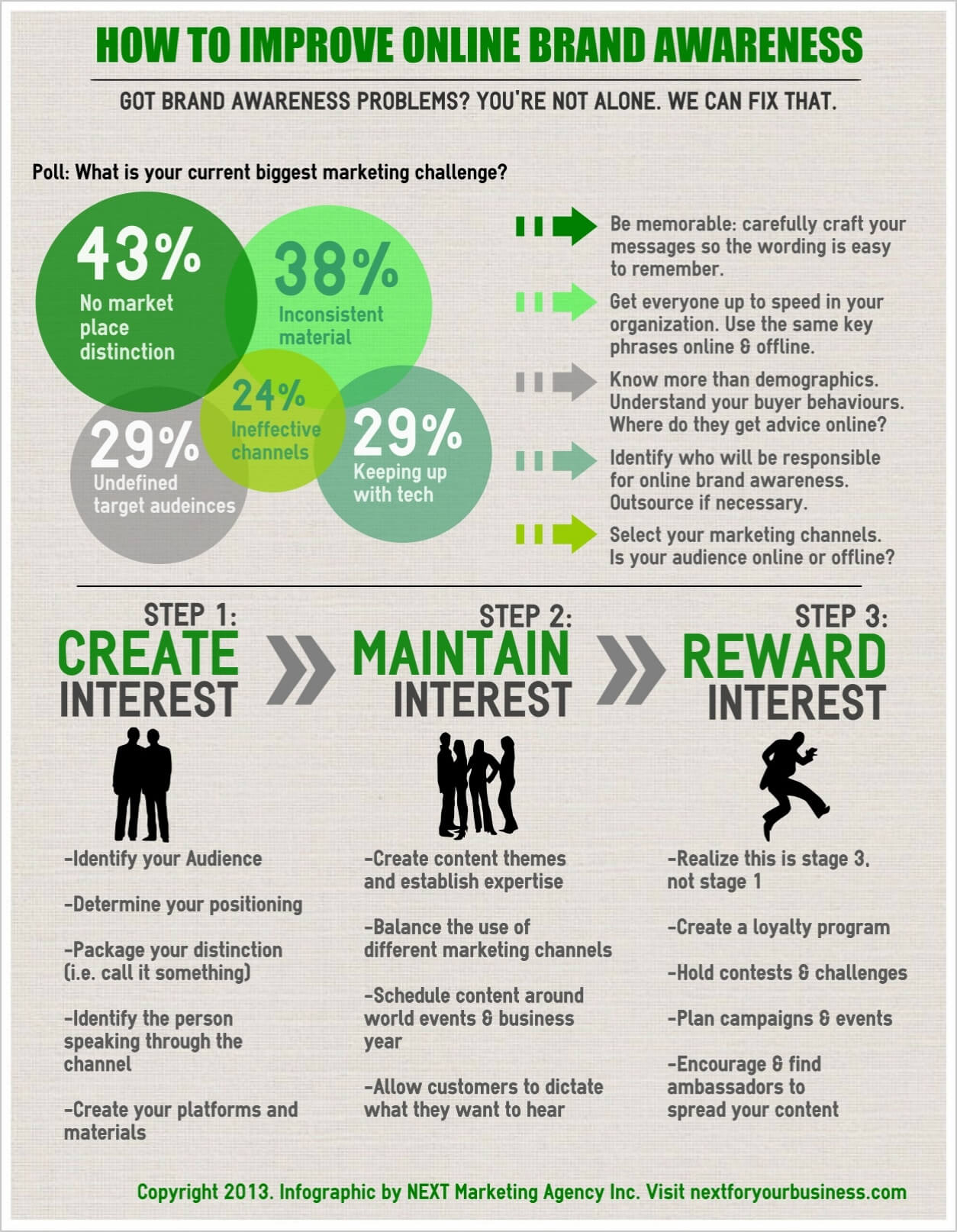NOTE: This blog post was originally written for an appeared on the NEXT Marketing Agency’s website, which is no longer in use. I am posting it here to showcase a reference to my writing portfolio. The strategy in the infographic below is the brainchild of Sandy Gerber. The article was an elaboration on a webinar hosted by Sandy, with further additions of references by myself. See this post that explains the writing I did for this marketing agency: Being a marketing writer / ghost blogger for a marketing agency
Got online brand awareness problems? You’re not alone, we can fix that.
Since holding our online BRAND CHATTER Webinar, we learned that our audience was having difficulties with their online brand awareness. So we developed an infographic for you to keep handy as a simple, yet effective reminder of how to be successful with your online branding strategy. Remember, it’s not just about being there – it’s about WHAT you are saying. If you are only blasting information about your company, or jumping in to hold a contest to get more fans, you are likely going to experience little, if no effectiveness. The goal is to get your audience to remember you, not just see you and forget you.
Sometimes people think that marketing is mainly a lot of creative ideas that spike up here and there. This is far from the truth. At its root, marketing has systems and processes. It is important to set up a methodology that will work for your needs, and by that we mean a method that will attract your audience. To do this takes consistency, planning and considerable thought into how your plans and actions will take shape and achieve your goals. This is not just the case with online brand awareness, but with all marketing a company does.
So here we have a bit of an extended explanation of our infographic, which we hope you will share and make good use of.
First off, CAREFULLY craft your messages. This means that you put thought into what you are saying, making sure it will resonate with your target audience. Your message should:
Use wording that is easy to remember – not too lengthy, not too technical and not lingo that only people in your industry would understand.
Accurately promote your distinction – how are you different? Do you use a technique no one else uses? Do you provide something as an ‘addition’ to your service or product your competitors don’t include in their offering? Can you say you’re “not just ______”? Whatever way you say it, your WORDS need to promote your distinction. Do you stand apart and lead the industry? It’s not enough to just be the “first” at something, if your competition has stolen market share away from you since you started – show how you have remained at the top of your game with something unique that you do or offer.
Be consistent and predictable in your delivery – believe it or not, when you post regularly, especially on a certain day and time, people get used to looking for your posts. Scott Berkun, an author and speaker, set up The Daily Post when he worked at Automattic, so his team would be forced to use the technology they were developing for other people. For some reason the blog took off and generated a lot of traffic, and he attributes part of that success to the name of the blog itself – it indicates when and how frequently readers can expect to get something new. Another example is Whiteboard Friday at SEOmoz – their entire community knows to expect a great, 10 minute video or quick SEO tip every Friday, which keeps people interested and coming back to their site.
Have a goal to create interest and sharing, not just to be there – if all you do is post about your company, then you can expect people will get bored. If you always post on the same topic, it may also create a lack of interest. This is a balance because you do not want to go completely off topic and share content that is not related to what you do, but on the other hand, you don’t want to be selling yourself in everything you say. One way around this is to create content themes – an area where you are an expert and can consistently show your expertise by covering an array of topics that are useful for your customers and audience to know about.
Most people tell us they suffer from “I don’t know what to say?” syndrome. We get it, and that’s where it’s important to first consider, ‘What is your message?’ – what is the main thing you want to get across to people? What will be of interest to them? What problems are you solving for your potential customers that they never thought of? That should be your starting point.
But then, it’s not just about saying it plain and simple – you need to be unique and creative about it. We see thousands of messages a day, and we just gloss over them. For example, a “No Parking” sign – we can easily not see or regard a sign like that, especially if it’s small and inconspicuous. But if the garage doorway to a warehouse says “Never, ever, ever, ever, ever, ever, ever park here” it will surely catch our attention, and we will never park there.
In our next blog posts, we plan to cover the three stages of BRAND CHATTER (i.e. online brand awareness and social coherence) so you get the full know-how and step-by-step guide of what to do, how to do it, and it what order.
